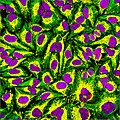HeLa
HeLa is a cell type in an immortal cell line used in scientific research. It is the oldest and most commonly used human cell line. The line was derived from cervical cancer cells taken on February 8, 1951, from Henrietta Lacks, a patient who died of cancer on October 4, 1951. The cell line was found to be remarkably durable and prolific, which warrants its extensive use in scientific research.
History[edit]
The cells from Henrietta Lacks were taken without her knowledge or consent, which was common practice at the time. Her family was not made aware of the line's existence until 1975. Since the cells' mass production and commercialization, Lacks's family have never received any financial compensation or recognition for their contribution.
Characteristics[edit]
HeLa cells are notable for their ability to reproduce indefinitely under specific conditions. This characteristic makes them a good model for studying the effects of various variables on cell growth and metabolism. They have been used in research to develop the polio vaccine, study cancer, and advance in vitro fertilization, cloning, and gene mapping.
Ethical Issues[edit]
The use of HeLa cells has raised ethical and legal issues, including informed consent and privacy. It has prompted changes in U.S. law and changes in practices regarding informed consent and compensation in genetic research.
In Popular Culture[edit]
The story of Henrietta Lacks and HeLa cells was popularized by Rebecca Skloot's 2010 book, The Immortal Life of Henrietta Lacks, and a subsequent HBO film of the same name starring Oprah Winfrey.
See Also[edit]
References[edit]
<references />
|
|
|
HeLa[edit]
-
HeLa-IV
-
HeLa-I
-
HeLa cells stained with antibody to actin (green), vimentin (red) and DNA (blue)
-
HeLa-Tubulin-HSP60-Fibrillarin-DNA
-
Henrietta Lacks statue, Bristol, RHS
-
HeLa-II
-
HeLa-III
-
HeLa-V
-
HeLa cells stained with Hoechst 33258
-
Ki67-Tubulin-2
-
Nuclear envelope of one cancerous HeLa cell
-
Plasma Membrane and Nuclear Envelope
Ad. Transform your life with W8MD's Budget GLP-1 injections from $75


W8MD offers a medical weight loss program to lose weight in Philadelphia. Our physician-supervised medical weight loss provides:
- Weight loss injections in NYC (generic and brand names):
- Zepbound / Mounjaro, Wegovy / Ozempic, Saxenda
- Most insurances accepted or discounted self-pay rates. We will obtain insurance prior authorizations if needed.
- Generic GLP1 weight loss injections from $75 for the starting dose.
- Also offer prescription weight loss medications including Phentermine, Qsymia, Diethylpropion, Contrave etc.
NYC weight loss doctor appointmentsNYC weight loss doctor appointments
Start your NYC weight loss journey today at our NYC medical weight loss and Philadelphia medical weight loss clinics.
- Call 718-946-5500 to lose weight in NYC or for medical weight loss in Philadelphia 215-676-2334.
- Tags:NYC medical weight loss, Philadelphia lose weight Zepbound NYC, Budget GLP1 weight loss injections, Wegovy Philadelphia, Wegovy NYC, Philadelphia medical weight loss, Brookly weight loss and Wegovy NYC
|
WikiMD's Wellness Encyclopedia |
| Let Food Be Thy Medicine Medicine Thy Food - Hippocrates |
Medical Disclaimer: WikiMD is not a substitute for professional medical advice. The information on WikiMD is provided as an information resource only, may be incorrect, outdated or misleading, and is not to be used or relied on for any diagnostic or treatment purposes. Please consult your health care provider before making any healthcare decisions or for guidance about a specific medical condition. WikiMD expressly disclaims responsibility, and shall have no liability, for any damages, loss, injury, or liability whatsoever suffered as a result of your reliance on the information contained in this site. By visiting this site you agree to the foregoing terms and conditions, which may from time to time be changed or supplemented by WikiMD. If you do not agree to the foregoing terms and conditions, you should not enter or use this site. See full disclaimer.
Credits:Most images are courtesy of Wikimedia commons, and templates, categories Wikipedia, licensed under CC BY SA or similar.
Translate this page: - East Asian
中文,
日本,
한국어,
South Asian
हिन्दी,
தமிழ்,
తెలుగు,
Urdu,
ಕನ್ನಡ,
Southeast Asian
Indonesian,
Vietnamese,
Thai,
မြန်မာဘာသာ,
বাংলা
European
español,
Deutsch,
français,
Greek,
português do Brasil,
polski,
română,
русский,
Nederlands,
norsk,
svenska,
suomi,
Italian
Middle Eastern & African
عربى,
Turkish,
Persian,
Hebrew,
Afrikaans,
isiZulu,
Kiswahili,
Other
Bulgarian,
Hungarian,
Czech,
Swedish,
മലയാളം,
मराठी,
ਪੰਜਾਬੀ,
ગુજરાતી,
Portuguese,
Ukrainian














